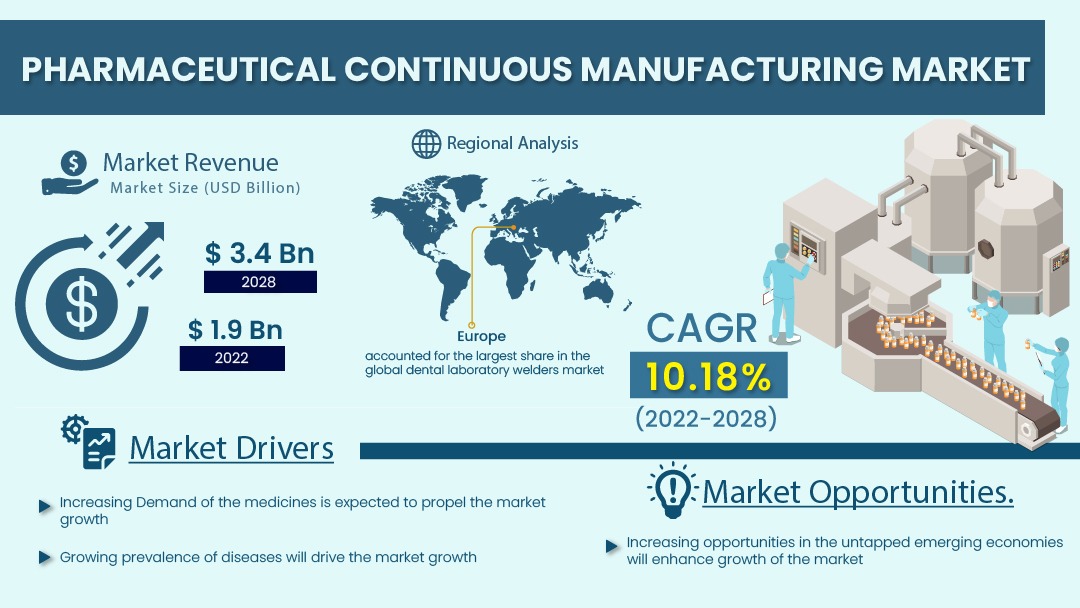Pharmaceutical Continuous Manufacturing Market (Product - Integrated Continuous Systems, and Semi Continuous Systems; Application - Final Drug Product Manufacturing, and API Manufacturing; End-user - Pharmaceutical Companies, and Contract Manufacturing Organization): Global Industry Analysis, Trends, Size, Share and Forecasts to 2028
A recent report published by
Infinium Global Research on the pharmaceutical continuous manufacturing market
provides an in-depth analysis of segments and sub-segments in the global as well
as the regional pharmaceutical continuous manufacturing market. The study also
highlights the impact of drivers, restraints, and macro indicators on the
global and regional pharmaceutical continuous manufacturing market over the
short term as well as long term. The report is a comprehensive presentation of
trends, forecasts, and dollar values of the global pharmaceutical continuous
manufacturing market. According to the report, the global pharmaceutical
continuous manufacturing market is projected to grow at a CAGR of 10.18% over the
forecast period of 2022-2028.
Market Insight
The global pharmaceutical
continuous manufacturing market was valued at about USD 1.9 Billion in 2022 and
is expected to reach over USD 3.4 Billion in 2028, with a CAGR of 10.18% during
the forecast period. A method used to manufacture or process raw material
without interruption is called continuous manufacturing or flow production.
Pharmaceutical continuous manufacturing technology reduces manual intervention
due to controlled units that provide a high level of automation. In the
pharmaceutical sector, the shift from the traditional batch manufacturing
method to the advanced continuous manufacturing technology is gaining momentum.
Furthermore, the growth of the market is attributed to the factors such as
increasing initiatives by regulatory authorities for the utilization of
continuous manufacturing technology. Moreover, the rising application of PCM
systems is expected to enhance the growth of the market during the forecast
period.

Productive capacity is the maximum
possible output of an economy. According to the United Nations Conference on
Trade and Development (UNCTAD), no agreed-upon definition of maximum output
exists. Hence utilization of production capacity in continuous manufacturing is
driving the growth of the market significantly. This manufacturing technology
provides a better way of manufacturing drug products that save time, improve
quality, create more flexibility in production quantities, and reduce required
production and the material that is to be developed this may turn into an
additional positive factor driving the demand growth. Moreover, FDA has
developed a program on the advancement of emerging technology applications to
modernize the pharmaceutical manufacturing base and frequent discussions with
the agency before the implementation of manufacturing technology. However, the
high implementation cost of automated units for continuous manufacturing is
likely to restrain the growth of the market. The Merger and acquisition and
joint venture among the leading player will bring more opportunities to this
market.
The outbreak of COVID-19 had
positive impacts on the pharmaceutical continuous manufacturing market during
the forecast period. The increasing utilization of medicine due to the
increased spread of the virus during the pandemic enhanced the production of
the pharmaceutical sector. The pharmaceutical sector was an essential element
during the covid-19 pandemic. The spread of the virus was increasing very
rapidly it increasing the demand for the medicines which propelled the growth
of the market during the forecast period. Furthermore, increasing healthcare
systems to treat chronic disease patients increased the utilization of the
technology during the covid-19 pandemic within the forecast period.
Based on the region, the worldwide
pharmaceutical continuous manufacturing market is segmented into the Asia
Pacific, North America, Europe, and also the Middle East & Africa. Europe
is expected to be the largest market for pharmaceutical continuous
manufacturing followed by Asia-Pacific. The demand for advanced technology is
high and the presence of many contract manufacturing organizations has boosted
the market in the region. The U.K. and Germany are the leading
revenue-generating countries in this region. Furthermore, the Asia Pacific is
expected to dominate the growth of the market during the forecast period. The
growth in the Asia Pacific is mainly driven by China and India, due to the
presence of a number of contract manufacturing companies.
Segment Covered
The report on global pharmaceutical
continuous manufacturing market covers segments such as product, application,
and end-user. On the basis of product, the sub-markets include integrated
continuous systems, and semi continuous systems. On the basis of application,
the sub-markets include final drug product manufacturing and API
manufacturing. On the basis of end-user, the sub-markets include pharmaceutical
companies, and contract manufacturing organization.
Companies Profiled:
The report provides profiles of
the companies in the market such as Johnson & Johnson’s, GEA, Korsch AG,
Siemens AG, Corning Life Sciences, Continuous Pharmaceutical, Scott Equipment
Company, S K Biotek Ltd, Chemtrix, and Thermo Fisher Scientific, Inc.
Report Highlights:
The report provides deep insights
into the demand forecasts, market trends, and micro and macro indicators. In
addition, this report provides insights into the factors that are driving and
restraining the growth in this market. Moreover, The IGR-Growth Matrix analysis
given in the report brings an insight into the investment areas that existing
or new market players can consider. The report provides insights into the
market using analytical tools such as Porter's five forces analysis and DRO
analysis of the pharmaceutical continuous manufacturing market. Moreover, the study
highlights current market trends and provides forecasts from 2022-2028. We also
have highlighted future trends in the market that will affect the demand during
the forecast period. Moreover, the competitive analysis given in each regional
market brings an insight into the market share of the leading players.
